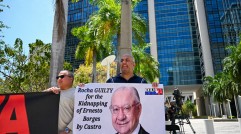Immigration News Today: DACA Recipients Benefit From Obtaining Driver's Licenses
President Barack Obama's deferred action executive actions have provided undocumented immigrants with the paperwork to apply for a driver's license, in eligible states, but challenges still remain as detailed in a new Pew Charitable Trusts report.
In the "Deciding Who Drives: State choices surrounding unauthorized immigrants and driver's licenses" report, a survey found 57 percent of undocumented immigrants applied and received a driver's license. The 57 percent were recipients of Obama's Deferred Action for Childhood Arrivals (DACA) program, which launched in 2012 and allowed eligible undocumented immigrants to temporarily avoid deportation by two years. The two-year DACA program is renewable, and in November 2014, Obama increased the deferred period to three years.
Some states have challenged DACA recipients' hopes to obtain a driver's license.
In 2012, Arizona and Nebraska tried to prohibit DACA beneficiaries from being issued a driver's license. In 2014, the Ninth Circuit U.S. Court of Appeals ruled against Arizona's attempt to deny licenses to DACA recipients, which was a decision the U.S. Supreme Court also upheld on Dec. 17, 2014. In May 2015, following a couple of lawsuits, the Nebraska Legislature overrode a governor's veto that allowed DACA recipients to obtain a state driver's license.
Obama's November 2014 executive actions would have increased the number of undocumented immigrants to apply for a driver's license, since the Deferred Action for Parental Accountability (DAPA) program would have allowed eligible parents of U.S. citizens or permanent lawful children to temporarily stay in the country. The expanded DACA and DAPA programs have been delayed pending an ongoing lawsuit.
"If these [DACA and DAPA] programs go into effect, many more people could receive deferred action and states could again face choices about whether to issue them driver's licenses," the Pew Charitable Trusts report stated. "Even without specific new legislation to extend license eligibility to unauthorized immigrants, states that issue licenses to deferred action recipients then could see increases in the number of people eligible for these licenses."
According to Pew, nearly 37 percent of undocumented immigrants live in jurisdictions that grant them a driver's license. The 11 jurisdictions are California, Colorado, Connecticut, Illinois, Maryland, Nevada, New Mexico, Utah, Vermont, Washington State and Washington, D.C. Among the 11 aforementioned jurisdictions, California has the highest undocumented immigrant population with an estimated 2.5 million. Illinois ranked second, followed by Maryland, with 475,000 and 250,000 undocumented immigrants, respectively.
States seeking to expanding its driver's license program to undocumented immigrants are recommended to consider a variety of changes, including startup expenses, new employees, potential revenue from application fees and accuracy of projected undocumented immigrants who will apply and eventually renew licenses.
In California, the state's 2014-2015 budget set aside $67.4 million for licenses to undocumented immigrants. For Illinois, the state allocated $800,000 for the first year, and $250,000 for following years, since they already estimated projections between 250,000 and one million total immigrant applicants.
Must Read: Immigration Reform Legislation Not Happening in 114th Congress, Says Senate Leader Mitch McConnell
__
For the latest updates, follow Latin Post's Politics Editor Michael Oleaga on Twitter: @EditorMikeO or contact via email: m.oleaga@latinpost.com.
Subscribe to Latin Post!
Sign up for our free newsletter for the Latest coverage!













